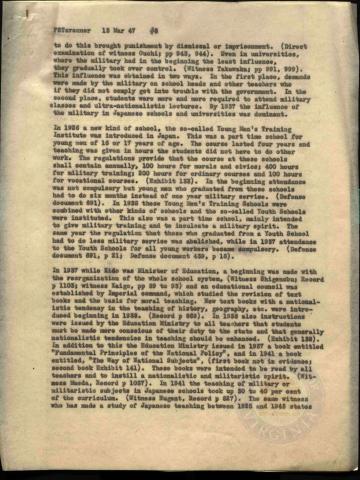
Page 3
| Parent | Educational System in Japan |
|---|---|
| Date | 13 March 1947 |
| Language | English |
| Collection | Tavenner Papers & IMTFE Official Records |
| Box | Box 4 |
| Folder | General Reports and Memoranda from March 1947 |
| Repository | University of Virginia Law Library |
FSTavenner 13 Mar #3
to do this brought punishment by dismissal or imprisonment. (Direct examination of witness Ouohi; pp 943, 944). Even in universities, where the military had in the beginning the least influence, they gradually took over control. (Witness Takawaka) pp 991, 999). This influence was obtained in two ways. In the first place, demands were made by the military on school heads and other teachers who if they did not comply got into trouble with the government. In the second place, students were more and more required to attend military classes and ultra-nationalistic lectures. By 1937 the influence of the military in Japanese schools and universities was dominant.
In 1926 a new kind of school, the so-called Young Men's Training Institute was introduced in Japan. This was a part time school for young men of 16 or 17 years of age. The course lasted four years end teaching was given in hours the students did not have to do other work. The regulations provide that the course at these schools shall contain annually, 100 hours for morals and civics; 400 hours for military training; 200 hours for ordinary courses and 100 hours for vocational courses. (Exhibit 133). In the beginning attendance was not compulsory but young men who graduated from these schools had to do six months instead of one year military service. (Defense document 691). In 1935 these Young Men's Training Schools were combined with other kinds of schools and the so-called Youth Schools were instituted. This also was a part time school, mainly intended to give military training and to inculcate a military spirit. The same year the regulation that those who graduated from a Youth School had to do less military service was abolished, while in 1937 attendance to the Youth Schools for all young workers became compulsory. (Defense document 691, p 21; Defense document 439, p 16).
In 1987 while Kido was Minister of Education, a beginning was made with the reorganisation of the whole school system, (Witness Shigenobu; Record p 1108) witness Kaigo, pp 89 to 98) and an educational council was established by Imperial command, which studied the revision of text books and the basis for moral teaching. New text books with a national¬istic tendency in the teaching of history, geography, etc. were intro¬duced beginning in 1938. (Record p 869). In 1938 also instructions were issued by the Education Ministry to all teachers that students must be made more conscious of their duty to the state and that generally nationalistic tendencies in teaching should be enhanced. (Exhibit 138). In addition to this the Education Ministry issued in 1937 a book entitled "Fundamental Principles of the National Policy", and in 1941 a book entitled, "The Way of National Subjects", (first book not in evidence; second book Exhibit 141). These books were intended to be read by all teachers and to instill a nationalistic and militaristic spirit. (Wit¬ness Nugent, Record p 1037). In 1941 the teaching of military or militaristic subjects in Japanese schools took up 80 to 40 per cent of the curriculum. (Witness Nugent, Record p 827). The same witness who has made a study of Japanese teaching between 1926 and 1945 states
